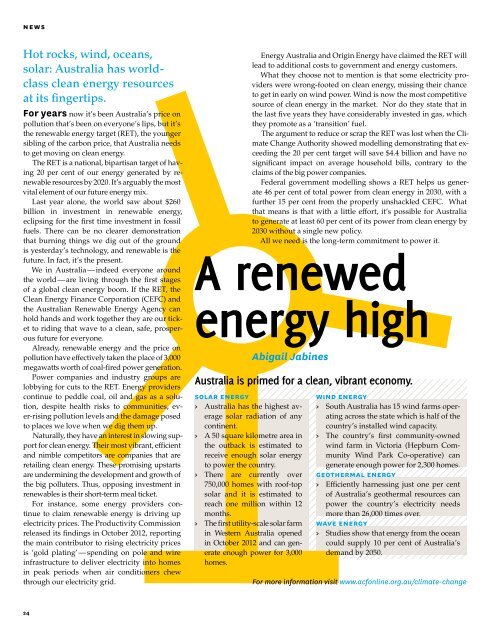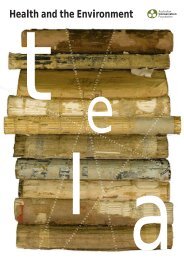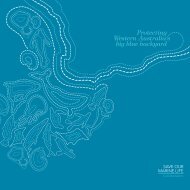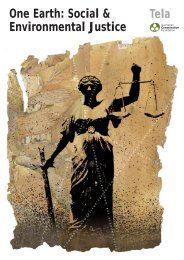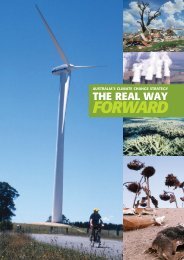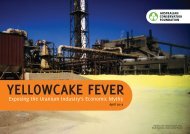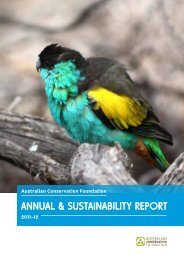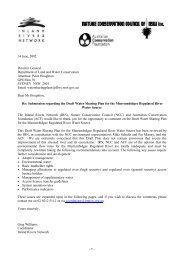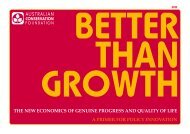habitat magazine - Australian Conservation Foundation
habitat magazine - Australian Conservation Foundation
habitat magazine - Australian Conservation Foundation
You also want an ePaper? Increase the reach of your titles
YUMPU automatically turns print PDFs into web optimized ePapers that Google loves.
news<br />
Hot rocks, wind, oceans,<br />
solar: Australia has worldclass<br />
clean energy resources<br />
at its fingertips.<br />
For years now it’s been Australia’s price on<br />
pollution that’s been on everyone’s lips, but it’s<br />
the renewable energy target (RET), the younger<br />
sibling of the carbon price, that Australia needs<br />
to get moving on clean energy.<br />
The RET is a national, bipartisan target of having<br />
20 per cent of our energy generated by renewable<br />
resources by 2020. It’s arguably the most<br />
vital element of our future energy mix.<br />
Last year alone, the world saw about $260<br />
billion in investment in renewable energy,<br />
eclipsing for the first time investment in fossil<br />
fuels. There can be no clearer demonstration<br />
that burning things we dig out of the ground<br />
is yesterday’s technology, and renewable is the<br />
future. In fact, it’s the present.<br />
We in Australia — indeed everyone around<br />
the world — are living through the first stages<br />
of a global clean energy boom. If the RET, the<br />
Clean Energy Finance Corporation (CEFC) and<br />
the <strong>Australian</strong> Renewable Energy Agency can<br />
hold hands and work together they are our ticket<br />
to riding that wave to a clean, safe, prosperous<br />
future for everyone.<br />
Already, renewable energy and the price on<br />
pollution have effectively taken the place of 3,000<br />
megawatts worth of coal-fired power generation.<br />
Power companies and industry groups are<br />
lobbying for cuts to the RET. Energy providers<br />
continue to peddle coal, oil and gas as a solution,<br />
despite health risks to communities, ever-rising<br />
pollution levels and the damage posed<br />
to places we love when we dig them up.<br />
Naturally, they have an interest in slowing support<br />
for clean energy. Their most vibrant, efficient<br />
and nimble competitors are companies that are<br />
retailing clean energy. These promising upstarts<br />
are undermining the development and growth of<br />
the big polluters. Thus, opposing investment in<br />
renewables is their short-term meal ticket.<br />
For instance, some energy providers continue<br />
to claim renewable energy is driving up<br />
electricity prices. The Productivity Commission<br />
released its findings in October 2012, reporting<br />
the main contributor to rising electricity prices<br />
is ‘gold plating’ — spending on pole and wire<br />
infrastructure to deliver electricity into homes<br />
in peak periods when air conditioners chew<br />
through our electricity grid.<br />
24<br />
Energy Australia and Origin Energy have claimed the RET will<br />
lead to additional costs to government and energy customers.<br />
What they choose not to mention is that some electricity providers<br />
were wrong-footed on clean energy, missing their chance<br />
to get in early on wind power. Wind is now the most competitive<br />
source of clean energy in the market. Nor do they state that in<br />
the last five years they have considerably invested in gas, which<br />
they promote as a ‘transition’ fuel.<br />
The argument to reduce or scrap the RET was lost when the Climate<br />
Change Authority showed modelling demonstrating that exceeding<br />
the 20 per cent target will save $4.4 billion and have no<br />
significant impact on average household bills, contrary to the<br />
claims of the big power companies.<br />
Federal government modelling shows a RET helps us generate<br />
46 per cent of total power from clean energy in 2030, with a<br />
further 15 per cent from the properly unshackled CEFC. What<br />
that means is that with a little effort, it’s possible for Australia<br />
to generate at least 60 per cent of its power from clean energy by<br />
2030 without a single new policy.<br />
All we need is the long-term commitment to power it.<br />
A renewed<br />
NBM-VQ26-CMYK.pdf 1 7/12/12 11:54 AM<br />
energy high<br />
Abigail Jabines<br />
Australia is primed for a clean, vibrant economy.<br />
solar energy<br />
> Australia has the highest average<br />
solar radiation of any<br />
continent.<br />
> A 50 square kilometre area in<br />
the outback is estimated to<br />
receive enough solar energy<br />
to power the country.<br />
> There are currently over<br />
750,000 homes with roof-top<br />
solar and it is estimated to<br />
reach one million within 12<br />
months.<br />
> The first utility-scale solar farm<br />
in Western Australia opened<br />
in October 2012 and can generate<br />
enough power for 3,000<br />
homes.<br />
wind energy<br />
> South Australia has 15 wind farms operating<br />
across the state which is half of the<br />
country’s installed wind capacity.<br />
> The country’s first community-owned<br />
wind farm in Victoria (Hepburn Community<br />
Wind Park Co-operative) can<br />
generate enough power for 2,300 homes.<br />
geothermal energy<br />
> Efficiently harnessing just one per cent<br />
of Australia’s geothermal resources can<br />
power the country’s electricity needs<br />
more than 26,000 times over.<br />
wave energy<br />
> Studies show that energy from the ocean<br />
could supply 10 per cent of Australia’s<br />
demand by 2050.<br />
For more information visit www.acfonline.org.au/climate-change


